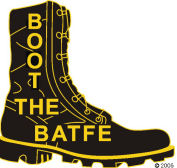

Three Roads to Perdition

(from videogameschronicle.com)
By Thomas E. Gift, MD. February 4, 2021
Article Source
Although for some years the editors of the Journal of the American Medical Association have clearly taken an approach to the Second Amendment that is a threat to civil rights, this article, “Three Interventions to Address the Other Pandemic–Firearm Injury and Death”, is more balanced than might be expected. That said, there is still the usual implication that somehow guns act on their own and if only they would change their behavior things would be better. And if firearm homicides decreasing each decade are “pandemic”, why is that term applied to the worldwide SARS-Cov-2 contagion?
The authors have three recommendations. The first of these is to enhance safe storage of firearms. On the face of it, who could argue? The issue becomes how burdensome such an approach might be. Presumably, we would be safer as automobile drivers if we all wore helmets, but most of us aren’t inclined to take this step due to the inconvenience and burden.
Similar issues arise with regard to firearms. Worse, while helmets presumably wouldn’t make us poorer drivers, some storage methods might make firearms for personal defense less readily available, making them less useful and us less safe if they are suddenly needed.
In this context, the authors discuss the possibility of family members or friends holding the firearm of someone who is experiencing a mental health crisis. This seems quite reasonable, although enemies of the Second Amendment have been successful enough in placing restrictions on who may possess firearms that family members, in many states, would be breaking the law if they performed that service.
In discussing this recommendation, the authors talk about acceptance “across the political spectrum.” This is always desirable, but as a rhetorical maneuver it tends to limit discussion and debate, and conveys support for a position which is more favorable to the Second Amendment’s enemies than to those of us seeking to preserve our civil rights.
A second recommendation, which has been more seldom discussed, is a voluntary do-not-sell list. This would entail laws allowing individuals to voluntarily and confidentially restrict their own ability to purchase firearms. This could be done by placing one’s name into the National Instant Criminal Background Check System to prevent gun purchases from dealers.
In states that have enacted such laws there are provisions to allow individuals to have their names removed later, but over only after a delay. They observe that under this law in Virginia, which goes into effect in 2021, the person can request removal from the list at any time, but such a request would take effect only after a 21-day waiting period.
Proponents believe that because many suicides seem impulsive, they will be prevented by waiting periods to purchase guns. But surveying other countries as well as our own history shows that suicide rates do not correlate at all with rates of civilian gun ownership.
Problems would arise from such legislation including using information about voluntary restriction as evidence that these individuals remain unfit to exercise their Second Amendment rights. They might also provide tools to be used against them in many other contexts, such as divorce or custody conflicts, or professional licensure. Although placing one’s name on such lists would supposedly be “confidential”, disclosure of “confidential” material may be compelled, or even stolen.
The third recommendation is for “red flag” laws, which have been widely discussed and found by Second Amendment advocates (like DRGO) to be highly problematic. Many concerns have been raised as to due process and the ongoing suspicion that these laws are something like the Hotel California–easy to lose your firearm, tough to get it back.
The idea of more responsible weapons storage raises the larger issue of learning gun safety. It seems probable that those favoring safe storage rules laws do not favor teaching firearm safety in schools as a means of reducing accidents involving guns. It is odd that many who see education as solving all manner of problems are reluctant to see it as the key to firearms safety.
As they begin their paper, the authors talk about the Biden administration’s likely attention to reducing firearm related deaths and injuries, and in this context note that “there are limits to what policies could be implemented at the federal level given the makeup of the new Congress and the Supreme Court.” Fortunately, it is hard to imagine the current Court endorsing greater restrictions on gun ownership.
But the new administration is a different beast. Its own stated goals encompass suppressing the right to keep and bear arms, rather than defending Americans’ constitutional rights as was sworn on January 20.
Author:
—Thomas E. Gift, MD is a child and adolescent psychiatrist practicing in Rochester, New York, an associate clinical professor of psychiatry at the University of Rochester Medical School, and a Distinguished Fellow of the American Psychiatric Association.
![]()

























